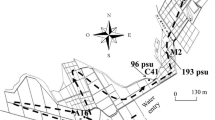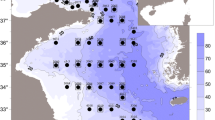Abstract
Macrozooplankton were sampled bi-weekly from October 1969 through May 1973 at 16 stations. Hydrological measurements, including water temperature and conductivity, accompanied each biological sample. Sampling sites and species were grouped by cluster analysis using Camberra-Metric measure of dissimilarity and flexible sorting. Two major seasons, based on taxon composition and abundance, were identified: A warm season (average water temperature above 22°C) dominated by larval and juvenile crustaceans, and a cool season with an abundance of larval fishes. Sites were more similar to each other within a year than they were between years. Differences between years correlated with variations in salinity and temperature. Community structure indices (Shannon-Weaver diversity, species richness and “evenness”) were applied to the seasonal data. Shannon diversity and “evenness” were positively correlated with each other, but richness values were often negatively correlated with the other two indices.
Similar content being viewed by others
Literature Cited
Boesch, D. F. 1973. Classification and community structure of macrobenthos in the Hampton Roads area Virginia. Mar. Biol. 21:226–244.
Boesch, D. F. 1977. Applications of numerical classification in ecological investigations of water pollution. Ecol. Res. EPA-600/3-77-033. 114p.
Clifford, H. T., andW. Stephenson 1975. An Introduction to Numerical Classification. Academic Press, New York. 229 p.
Dahlberg, M. P., andE. P. Odum. 1970. Annual cycles of species occurrence, abundance and diversity in Georgia estuarine populations.Am. Midl. Nat. 83:382–392.
Field, J. G. 1970. The use of numerical methods to determine benthic distribution patterns from dredgings in False Bay.Trans. R. Soc. S. Afr. 39:183–200.
Gallaway, B. J., andK. Strawn. 1975. Seasonal and areal comparisons of fish diversity indices at a hot-water discharge in Galveston Bay, Texas.Contrib. Mar. Sci. 19:79–89.
Gunter, G. 1938. Seasonal variation in abundance of certain estuarine marine fishes in Louisiana with particular references to life histories.Ecol. Monog. 8:313–346.
Gunter, G. 1945. Studies on marine fishes in Texas.Publ. Inst. Mar. Sci. 1:1–190.
Gunter, G., B. S. Ballard, and A. Venkatarmaiah. 1973. Salinity Problems of Organisms in Coastal Areas Subject to the Effect of Engineering Works. Gulf Coast Research Lab. Report H-73-3, Ocean Springs, Miss. 176 p.
Hoese, H. D. 1965. Spawning of marine fishes in the Port Aransas, Texas area as determined by the distribution of young and larvae. Ph.D. Dissertation, Univ. Texas. 144 p.
Holt, J. 1976. Community structure of macro-zoo-plankton in Trinity and upper Galveston Bays, with special reference to the cooling water system of Cedar Bayou Electric Generating Station. Ph.D. Dissertation. Texas A&M University, 96 p.
Holt, S. 1976. Temporal and spatial distributions of fishes in Trinity and upper Galveston Bays, with particular reference to possible effects of the cooling water system of Cedar Bayou Electric Generating Station, M.S. Thesis, Texas A&M University, 160 p.
Johnson, R. B., Jr. 1974. Ecological changes associated with the industrialization of Cedar Bayou and Trinity Bay, Texas. Texas Parks and Wildlife Dept. Tech. Series No. 16. 79 p.
Jones, T. L. 1975. Species composition, distribution and abundance of macro-zooplankton in the intake and discharge areas after construction and operation of the Cedar Bayou Electric Power Station. M.S. Thesis, Texas A&M University, 217 p.
Kalke, R. D. 1972. Species composition, distribution, and seasonal abundance of macro-zooplankton in the intake and discharge areas before and during early operation of the Cedar Bayou Generating Station. M.S. Thesis, Texas A&M University, 186 p.
Larsen, P. F. 1979. The shallow-water macrobenthos of a northern New England estuary.Mar. Biol. 55:69–78.
McBee, J. T., Jr. 1975. Species composition, distribution, and abundance of macrobenthic organisms in the intake and discharge areas before and after the construction of the Cedar Bayou Electric Station. Ph.D. Dissertation, Texas A&M University, 205 p.
McErlean, A. J., S. G. O'Connor, J. A. Mihursky, andC. I. Gibson. 1973. Abundance, diversity and seasonal patterns of estuarine fish populations.Estuarine Coastal Mar. Sci. 1:19–36.
Nie, N. H., C. H. Hull, J. G. Jenkins, K. Steinbrenner, andD. H. Brent, Editors. 1975. SPSS: Statistical package for the social sciences. 2nd edition. McGraw-Hill, New York. 675 p.
Pielou, E. C. 1966a. Shannon's formula as a measure of specific diversity: its use and misuse.Am. Nat. 100:463–465.
Pielou, E. C. 1966b. The measurement of diversity in different types of biological collections.J. Theor. Biol. 13:131–144.
Poff, M. J. 1973. Species composition, distribution, and abundance of macrobenthos organisms in the intake and discharge areas after construction and operation of the Cedar Bayou Electric Power Station. M.S. Thesis, Texas A&M University, 348 p.
Stephenson, W., W. T. Williams, andS. D. Cook 1972. Computer analysis of Petersen's original data on bottom communities.Ecol. Monogr. 42:387–415.
Strawn, K., R. D. Reimer, M. Poff, T. Jones, G. Williams, and K. Johnson. 1972. A supplement to the progress report for October 1969–December 1971. Species diversity and abundance of the bottom fauna, macroplankton, commercially important crabs and shrimp, and fishes, before and after construction of the Cedar Bayou Generating Station. Texas A&M Univ. TAES Proj. 1774 College Station. 367 p.
Strawn, K., K. Johnson, T. McBee, J DeBusk, C. Williams, and S. Holt. 1973 Progress Report for 1972. Species diversity and abundance of the bottom fauna, macroplankton, commercially important crabs and shrimp, and fishes, before and after construction of the Cedar Bayou Generating Station. Texas A&M Univ. TAES Proj. 1774, College Station. 369 p.
Vernberg, W. B., P. J. DeCoursey, andJ. O'Hara. 1974. Multiple environmental effects on physiology and behavior of the fiddler crab,Uca Pugilator, p. 381–425.In F. J. Vernberg and W. B. Vernberg (eds.), Pollution and Physiology of Marine Organisms. Academic Press, New York.
Williams, A. B. 1965. Marine Decapod Crustacea of the Carolinas.U.S. Fish Wildl. Serv. Bull. 65:1–298.
Wilhm, J. H., andT. C. Dorris. 1968. Biological parameters for water quality criteria.Bioscience. 18: 477–481.
Author information
Authors and Affiliations
Rights and permissions
About this article
Cite this article
Holt, J., Strawn, K. Community structure of macrozooplankton in Trinity and Upper Galveston Bays. Estuaries 6, 66–75 (1983). https://doi.org/10.2307/1351808
Received:
Accepted:
Issue Date:
DOI: https://doi.org/10.2307/1351808




